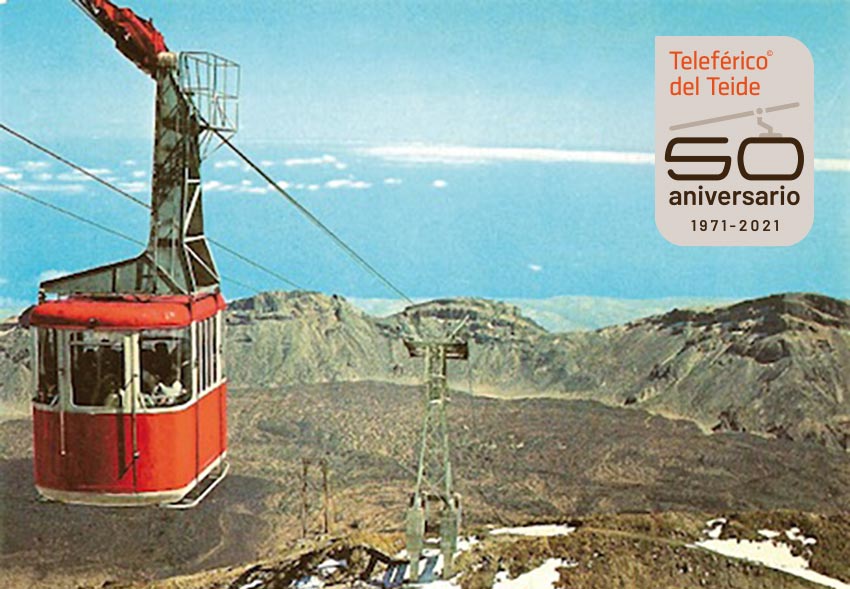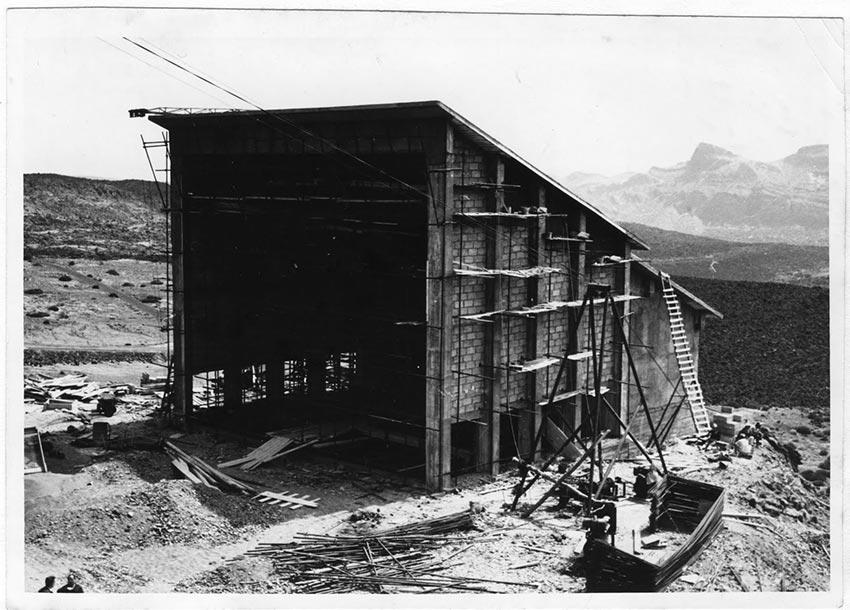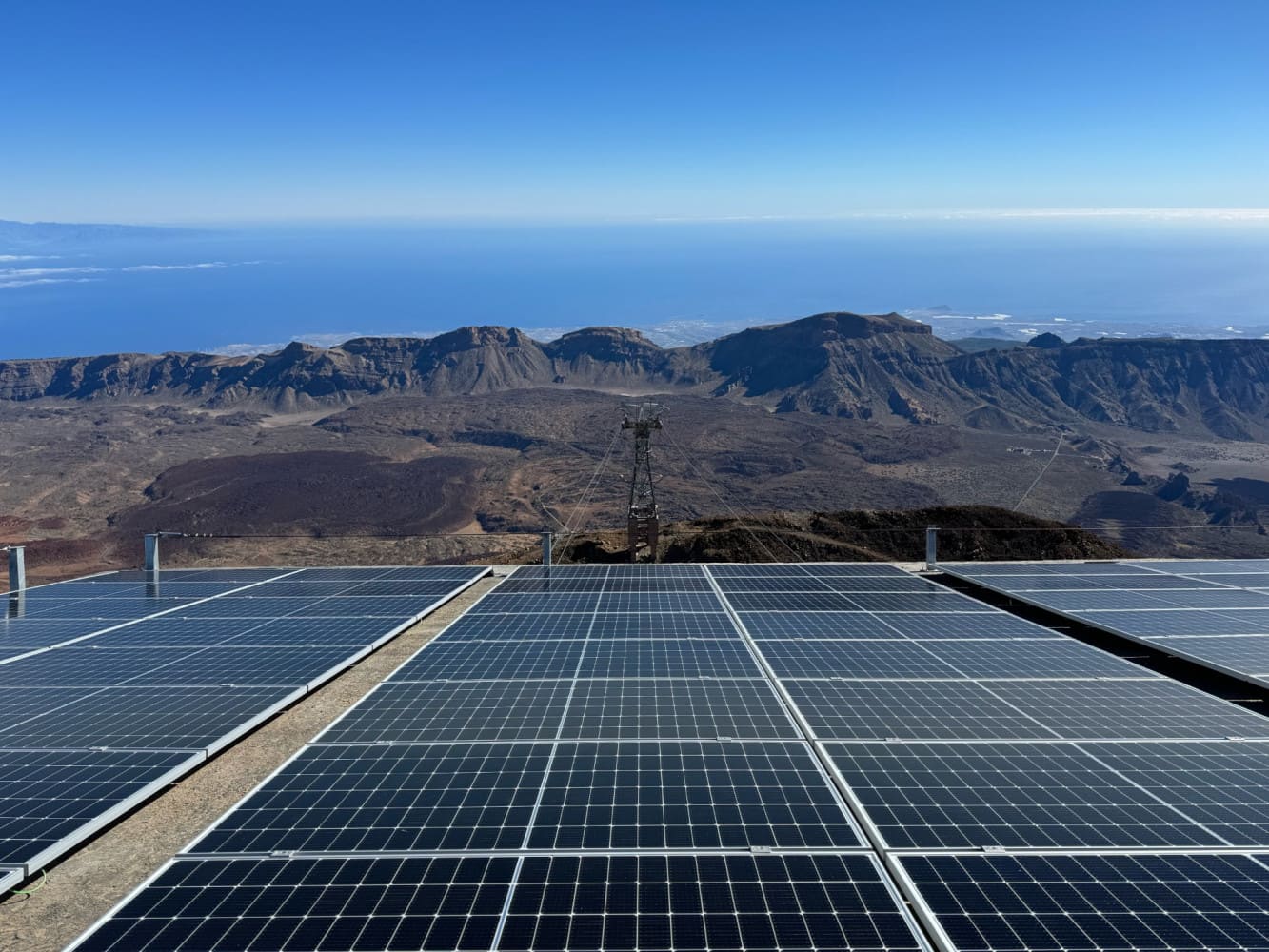History of the Cable Car
In 2021 the Teide cable car service celebrated its 50th anniversary. An engineering challenge shared with all the inhabitants of Tenerife.

TABLE OF CONTENTS
Background to the Teide Cable Car

Throughout our history, several ideas and proposals emerged to construct a cable car system to make it possible for all kinds of visitors to travel to the peak of Mount Teide.
However, the only project to eventually see the light of day was suggested by Don Andrés de Arroyo y González de Chávez.
During his travels in Germany and Switzerland back in 1929, he had been impressed by the number of funicular railways in the regions he was visiting, and by the superb views afforded from the height of the stations.
On his return, he decided to spare no effort in providing Mount Teide with a funicular railway that would provide access for all visitors, so that they could enjoy the wonderful views from the peak.
The project: the first steps towards a cable car system

The initial construction project was drawn up in 1930 by the Engineer for Roads, Canals and Ports, Don José Ochoa Benjumea. This was an aerial railway system divided into two sections: The first would connect Montaña Majúa with Montaña Fría, with two cabins travelling to and fro, and capacity for 35 passengers. The second section would depart from Montaña Fría with a single cabin for up to 15 passengers, finishing at the terminus.
In 1960, the final report and project were written for the building of the system, based on the original project drafted by Engineer Ochoa.
In the definitive project, the site of the first station was switched from Montaña Majúa to its current location, eliminating the need for one tower and reducing the cost of cable.
The final project was drawn up by the Engineer for Roads, Canals and Ports, Don Miguel Pintor Domingo and the industrial engineer Don Francisco Trujillo Armas.
The layout of the cable car track

The specific route was chosen to take advantage of the sloping terrain; this made it easier to build the derricks or towers, as it aligned the initial station with the only place where the intermediate station could be sited, given that the land is solid rock. In addition, this meant that derricks were not needed for the construction of the upper station.
- The Teide cable car operates as a push-pull system, using two cabins that travel using a traction cable.
- Each cabin glides along an additional cable that acts as a track, travelling for almost 2.5 kilometres and reaching a maximum speed of 8 metres per second.
- During the journey, the cabins pass through four 50-metre-tall towers that support the cables.
- Over the entire journey, the cable car ascends 1,200 metres, with the upper station sited at 3,555 metres above sea level.
Building the cable car: start and completion dates

Construction of the cable car system began in April 1962, with the marking out of the route the track would take and with surveys of the land. This work was completed in 1963, and it determined the exact location of the stations and the four derricks or towers that would support the cable.
Building work began on the 4th of September 1963 with the excavation for the construction of the access road to the site of the base station. Construction of the cable car system took 8 years, and was completed on the 27th of July 1971 with the signing of the provisional certificate of acceptance for the first section of the funicular railway.
The main difficulties occurred in winter, as snowfall and low temperatures meant that it was often only possible to work on the base station.
To begin with, building materials were brought up by donkeys (or even carried on the shoulders of the workmen themselves) until a hoist was installed, and in 1967 an auxiliary cable car track was brought into operation, speeding up the building work.
The civil works and the foundations were undertaken by Entrecanales y Tabora S.A., while the installation of the funicular railway itself was carried out by the Italian company Ceretti e Tanfani S.A.
The cable car’s inaugural journey

- The cable car opened on the 18th of July 1971.
- On the second of August 1971, it went into operation—the start of a new adventure for the Canary Islands.
A unique project that, since that first journey, has been enjoyed by every one of our visitors.
The refurbishment of the cable car

Between 1999 and 2007 a project to refurbish the system was undertaken:
- The existing cabins were replaced by new ones with a more modern, aerodynamic design.
- The aerial tramway, the traction cables and the four towers were also replaced.
- Improvements were made to the stations to bring them into line with new requirements and to bring them into harmony with their surroundings.
- All the machinery as well as the electrical power plant were also renewed.
- In addition, the safety and control systems were changed, and a plan was put into place for regular safety reviews.
A significant milestone was reached between 2007 and 2008 when the towers were renewed without interrupting the passenger service, an achievement recognised by the award of the Agustín de Betancourt Prize for the best civil engineering project for the 2007-2009 three-year-period.
The energy transition of the Teide Cable Car
In 2024, the Teide cable car system reached a milestone in terms of sustainability when it became the first cable car service in the world not connected to mains electricity, but operating exclusively on solar energy.

From its early days, the energy used by the Teide cable car system came from diesel engines, as it was not possible to connect the system to the island’s electricity grid.
However, the need to reduce its environmental footprint in a protected natural area led to an ambitious project to transition to a model based on renewable energies.
This challenge was met on the 24th of September 2024, when the cable car system began to operate using 100% renewable energy.
This transition has resulted in the elimination of the equivalent of 600 tonnes of CO2 emissions annually.
The use of solar energy has transformed the Teleférico into a model of sustainability and energy efficiency, reaffirming its commitment to responsible tourism and to preserving the natural heritage of the Teide National Park for future generations.

* Authorship of the images and text of the History of the Cable Car (up to the section ‘The energy transition of the Teide Cable Car’) by Rafael Cedrés.
LinkedIn: Rafael Cedrés Jorge
Further information:


